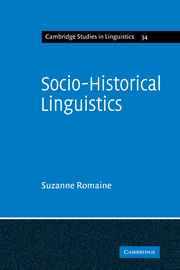Book contents
- Frontmatter
- Contents
- Dedication
- Preface
- Dedication
- 1 Methodology and aims
- 2 Methods for a sociolinguistic study of historical syntax
- 3 The history of the relative clause/markers in English with special reference to Middle Scots
- 4 The linguistic variables
- 5 The extralinguistic variables: methods for the reconstruction of language in its social context
- 6 Analysis of the data by two sociolinguistic techniques: cross-product analysis and implicational scaling
- 7 Variable rule analysis of the data
- 8 The bearing of sociolinguistic data on linguistic hypotheses
- 9 On the epistemological status of sociolinguistic theory
- Bibliography
- Index
1 - Methodology and aims
Published online by Cambridge University Press: 05 May 2010
- Frontmatter
- Contents
- Dedication
- Preface
- Dedication
- 1 Methodology and aims
- 2 Methods for a sociolinguistic study of historical syntax
- 3 The history of the relative clause/markers in English with special reference to Middle Scots
- 4 The linguistic variables
- 5 The extralinguistic variables: methods for the reconstruction of language in its social context
- 6 Analysis of the data by two sociolinguistic techniques: cross-product analysis and implicational scaling
- 7 Variable rule analysis of the data
- 8 The bearing of sociolinguistic data on linguistic hypotheses
- 9 On the epistemological status of sociolinguistic theory
- Bibliography
- Index
Summary
In some areas of research it may appear possible to separate the linguistic from the socio-cultural, the synchronic from the diachronic or historical.
Dell Hymes 1971:423Brief description of the proposed study
Thus far, sociolinguistics has concerned itself primarily with the analysis of synchronic variable speech data. If, however, sociolinguistics is to reach the final goal set for it by Hymes (1974a: 206), namely, that it should preside over its own liquidation, then clearly sociolinguistics should itself be an integrative mode of description. I take Hymes' comment to mean that the subject matter of linguistics should not be confined to the study of the conceptual function of language, but should also include its social function or communicative use. What he argues for, then, is a general theory of language which comprises both aspects. Such a theory would dispense with the need for a separate sociolinguistic theory; in other words, sociolinguistics would be ‘redundant’ (Labov 1972a: 183).
The chances of sociolinguistics becoming such an integrative discipline are, in Hymes' opinion as well as my own, uncertain. Furthermore, I question whether a sociolinguistic theory in these terms is possible. My starting point is the assumption that if sociolinguistics is to meet the challenge given by Hymes, it must move beyond the treatment of synchronic phonetic and phonological data to a more general body of linguistic data. My study attempts to extend the application of variation theory from the domain of synchronic phonological variation to the study of a problem in historical syntax.
- Type
- Chapter
- Information
- Socio-Historical LinguisticsIts Status and Methodology, pp. 1 - 28Publisher: Cambridge University PressPrint publication year: 1982

